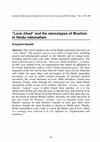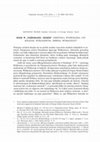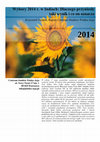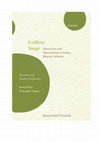Papers: Hindu Nationalism by Krzysztof Iwanek

Archiv Orientalni. Oriental Archive, 2015
The article is available in print in Archiv Orientalni, 2015, 83 (2), 255–280.
This article’s tw... more The article is available in print in Archiv Orientalni, 2015, 83 (2), 255–280.
This article’s two aims are to briefly describe the activities of a Hindu nationalist organisation commonly referred to as Vidya Bharati, particularly in the Indian state of Uttarakhand, and more specifically to analyse and describe the contents and political aims of its ideologically charged social science textbook called Gauravśālī Bhārat (“Glorious India”). Vidya Bharati, that is Vidya Bharati Akhil Bharatiya Shiksha Sansthan, is a part of a well-known and influential Hindu nationalist organisation, the Rashtriya Swayamsevak Sangh. The author describes how its textbook distorts the vision of history in order to mould the worldview of the students and their vision of contemporary Indian politics and society. The article also states that Gauravśālī Bhārat is probably an edited continuation of the earlier, controversial textbook called Gaurav Gāthā and that Vidya Bharati schools emulate the solutions of Christian missionary schools in some respects.
This article was published in the International Journal of Knowledge and Innovation in Business (... more This article was published in the International Journal of Knowledge and Innovation in Business (December, 2014, Volume 2, Number 1, pp.1-38). The work was supported by Hankuk University of Foreign Studies Research Fund of 2014.
The author is grateful to Jawaharlal Nehru Memorial Library for enabling him to pursue his research.

Politeja Vol 16 No 2(59), 2019
This article will consider whether the Bharatiya Janata Party (the BJP), the party currently ruli... more This article will consider whether the Bharatiya Janata Party (the BJP), the party currently ruling India, may be considered conservative. The author will use Swapan Dasgupta’s 2015 lecture on conservatism as a starting point for further deliberations. While agreeing with some of Dasgupta’s points, the author will conclude that the defining elements of Indian conservatism which he had proposed can, at the same time, define Hindu nationalism as well. To find the difference between the two, the text will consider a few historical examples of disputes and cooperation between the parties of the Hindu Right (and between Hindu conservatives and Hindu nationalists in general) such as the issue of the civil code reform, the attitude towards Dalits (untouchables) and the question of monarchy abolition. The final conclusion of the text is that while Hindu nationalism does share certain aspects and goals with Hindu conservatism, it also differs with it on some other points, and thus the BJP is more of a nationalist than a conservative party. It was the Ramrajya Parishad, a small and now defunct party, that in the author’s view represented the strand of Hindu conservatism.

‘Secularism’ as understood and interpreted by Hindu nationalists
Journal of Language and Politics, 2018
This article focuses on how Hindu nationalists interpret the term ‘secularism’ in Hindi. I will r... more This article focuses on how Hindu nationalists interpret the term ‘secularism’ in Hindi. I will refer to two Hindi translations of ‘secularism’: dharmnirpekṣtā and panthnirpekṣtā. The first one means indifference towards religion and the second indifference towards communities. My main point is that the Hindu nationalists’ strategy of referring to old, Sanskrit meanings of dharm (which means ‘law’ and ‘order’ aside ‘religion’ and other concepts) make it possible for them to criticise dharmnirpekṣtā and choose panthnirpekṣtā instead. Their position is that the state can only be indifferent to communities and not to dharm, as the latter would also mean being indifferent to ‘law’ and ‘order’. Such an approach helps the Hindu nationalists to claim to be in agreement with the idea of secular Indian state on one hand and promote their religion-linked ideology on the other.

Journal of Alternative Perspectives in the Social Sciences (2016) Volume 7 No 3, 355-399.
This a... more Journal of Alternative Perspectives in the Social Sciences (2016) Volume 7 No 3, 355-399.
This article analyses the recent Hindu nationalist discourse on " Love Jihad ". The primary sources were both of visual form, including posters and photographs posted on the Internet and of textual form, including Internet posts and other Hindu nationalist publications. The main analysed source will be the " Anti Love Jihaad Helpline " , a website of Anti Love Jihaad Front, an organisation that admits its affiliation to the Hindu Mahasabha, India's oldest Hindu nationalist party. The main argument of the text will be that while the whole issue of Love Jihad fits well within the main ideas and stereotypes of the Hindu nationalist movement, as well as within certain strategies of classical Sanskrit narratives, the recent discourse on Love Jihad introduces certain new elements. While through the controversy on Love Jihad Hindu nationalism strikes at two of its enemies: Western " corrupt " ways and Muslim " radical " ways, it deftly blends them together. As it is the Westernised Hindu girls that fall prey to Muslim boys that pretend to be Westernised, it is the threat of corrupt Western culture that opens the way for the threat of radical Muslim culture.
[I am sorry for many spelling - and other - mistakes that I missed in this paper.]

Sprawy Międzynarodowe, 2020
This article compares history teaching in two types of Hindi-language textbooks used in India. On... more This article compares history teaching in two types of Hindi-language textbooks used in India. One group of sources includes textbooks issued by the National Council of Educational Research and Training, a central public institution. The other one contains those published by Vidya Bharati Akhil Bharatiya Shiksha Sansthan, a network of private schools run by Hindu nationalists. The objective of this study is to analyse what political, identity-building purposes these two conflicted narratives on history reveal. Unsurprisingly, the author’s conclusion is that the Hindu nationalist textbooks are biased in a number of ways. They portray India as continuously assaulted by foreign forces across the ages and united by the Hindu religious traditions. The government textbooks also stress Indian national unity at times but do not build it on the bedrock of Hindu religious traditions. While part of their contents is tilted politically to the left, they are still more balanced than the publications of Hindu nationalists. They recognise diversity much more, challenge some of the common myths and biases, admit India’s various historical challenges and include perspectives of various social groups to a certain degree. The article’s concluding remarks also muse on whether and in what ways such debates on Indian history affect the country’s present domestic politics and foreign policy.
Hindutwa. Hinduski nacjonalizm w ujęciu Vinayaka Damodara Savarkara [in Polish][‘‘Hindutva. Vinayak Damodar Savarkar’s Hindu nationalism’]
In: A. Gotchold, J. Madajczak (eds.), Interdisciplinarity: A Travel Through Cultures – Interdyscy... more In: A. Gotchold, J. Madajczak (eds.), Interdisciplinarity: A Travel Through Cultures – Interdyscyplinarność: Podróż szlakiem kultur, Warszawa: Wydawnictwa Uniwersytetu Warszawskiego [Warsaw: Warsaw University Press], 2013, pp. 60-82.
[This is not a journal article.
Papers: India-Poland Relations by Krzysztof Iwanek

Pamiętnik Literacki CVII, 2016, z. 1, p. 81-96.
[The article has been written in Polish.]
This ar... more Pamiętnik Literacki CVII, 2016, z. 1, p. 81-96.
[The article has been written in Polish.]
This article seeks to analyse the importance of Indian motifs in Stanisław Ignacy Witkiewicz’s Pożegnanie
jesieni (Farewell to Autumn). It starts with claiming that while India and its aspects are depicted in
a very general and sometimes erratic way in the novel, Witkacy’s Farewell to Autumn cannot simply be
summed up using Edward W. Said’s (and Erazm Kuźma’s) method. India, and the East as such, is not
described here neither as a simple mirror image of the West nor any myth of it being construed. The
author’s conclusion is that rather with treating the vision of the East, the novel deals much more with
the image of certain Europeans fascinated with the East. In his opinion Hela’s conversion to Buddhism,
a crucial point in novel’s plot, is indicative of it. However, following Jan Tuczyński, the author finds it
possible that the final moment of the book, Atanazy’s death, may point out to setting a common ground
between elements of Witkacy’s philosophy and a certain concept from Indian classical schools of thought.
If that be the case, Witkacy might have meant that a true dialogue between the West and the East
should be based not on a superficial, “spiritual” journey to the East, but on a meaningful philosophical
search to find shared elements in Western and Eastern schools of thought.
Many thanks for Adam Burakowski for giving me a copy of "Farewell to Autumn". /
Dziękuję Adamowi Burakowskiemu za podarowanie mi egzamplarza ,,Pożegnania jesieni'' i wywołanie mojego zainteresowania tą książką.
This work was funded by the Hankuk University of Foreign Studies Fund of 2015. / Ta praca została sfinansowana przez grant Hankuk University of Foreign Studies z 2015 r.
This review is a comment to the review written by Jakub Zajączkowski, the head of the Centre for ... more This review is a comment to the review written by Jakub Zajączkowski, the head of the Centre for Contemporary India Research and Studies, Warsaw, Poland. As Jakub Zajaczkowski has found a rather controversial book to be of great value to the study of Polish-Indian relations, I feel the need to publicly disagree with him. It must be pointed out that the book in question is replete with serious mistakes as well as a large amount of passages overlapping, without proper references, with other publications.
Poniższa recenzja stanowi komentarz i sprostowanie do recenzji książki Macieja Tumulca, którą opu... more Poniższa recenzja stanowi komentarz i sprostowanie do recenzji książki Macieja Tumulca, którą opublikował w czasopiśmie Stosunki Międzynarodowe - International Relations dr Jakub Zajączkowski, dyrektor Centrum Badań nad Współczesnymi Indiami ISM UW. Recenzję niniejszą do tegoż czasopisma wysłałem jeszcze w zeszłym roku i otrzymałem potwierdzenie jej odbioru. Później jednak przez długie miesiące cierpliwego oczekiwania nie otrzymywałem żadnych informacji od redakcji i ostatecznie zdecydowałem, że w takim razie opublikuję ją w Internecie.
Papers: Indian Politics (other than Hindu Nat.) by Krzysztof Iwanek
Burakowski, Adam, Iwanek, Krzysztof "India’s Aam Aadmi (Common Man’s) Party. Are the Newcomers Ro... more Burakowski, Adam, Iwanek, Krzysztof "India’s Aam Aadmi (Common Man’s) Party. Are the Newcomers Rocking National Politics?" in Asian Survey, vol. 57, no. 3, May/ June 2017, pp. 528-547 (C) 2017 by the Regents of the University of California. Published by the University of California Press.
Abstract:
The Aam Aadmi Party (Common Man's Party, AAP) has taken over part of the program of the Indian National Congress. The AAP was able to include new solutions within the traditional political repertoire. In Delhi the AAP took over the traditional Congress electorate but was also able to reach out to the middle-class voter.

Krzysztof Iwanek, Raport Centrum Studiów Polska-Azja 2014 Wybory 2014 r. w Indiach: Dlaczego przy... more Krzysztof Iwanek, Raport Centrum Studiów Polska-Azja 2014 Wybory 2014 r. w Indiach: Dlaczego przyniosły taki wynik i co on oznacza W sobotę 17 maja poznaliśmy ostateczne wyniki największych wyborów świata. W niższej izbie parlamentu indyjskiego, Lok Sabsze (Lok Sabha, Izba Ludu) będzie odtąd dominować hinduska nacjonalistyczna partia Bharatiya Janata Party (BJP, Indyjska Partia Ludowa), która uzyskała 282 na 543 wybierane mandaty. Wiele rekordów pobito podczas tych wyborów. BJP po raz pierwszy zdobyła tak dużo mandatów i może rządzić samodzielnie, dotąd rządzący Indyjski Kongres Narodowy po raz pierwszy zdobył ich tak mało. Wybory te kosztowały więcej niż kiedykolwiek i przyniosły największą frekwencję. Głos oddało 66.4% obywateli, czyli 551 milionów spośród 814 milionów uprawnionych. W Lok Sabsze tej kadencji zasiądzie więcej niż kiedykolwiek kobiet (61), najmniej muzułmanów (22), więcej niż kiedykolwiek milionerów (449) i więcej niż kiedykolwiek osób z zarzutami popełnienia przestępstwa (186). Nowy premier, Narendra Modi, będzie pierwszym premierem Indii z Innych Zacofanych Kast (Other Backward Castes).Dostępny poniżej raport podzielony jest na cztery rozdziały. Podjąłem próbę zastanowienia się w nim, jakie są (1) ogólnokrajowe i (2) regionalne powody zwycięstwa BJP, jaka jest (3) sytuacja polityczna nowego rządu i (4) co nowy rząd może zmienić. Tekst starałem się ilustrować tabelkami.
Papers: Others by Krzysztof Iwanek
I have found certain passages from Chitra Sinha’s book 'Debating Patriarchy. The Hindu Code Bill ... more I have found certain passages from Chitra Sinha’s book 'Debating Patriarchy. The Hindu Code Bill Controversy in India (1941-1956)' (New Delhi: 2012) overlapping with passages in a few other texts. My observation refers only to pages 184-186.
The Influence of British Rule on the Formation of India’s Modern Intelligentsia
in: J. Kieniewicz (ed.), Inteligencja, Imperium i Cywilizacje w XIX i XX [‘Intelligentsia, Empire... more in: J. Kieniewicz (ed.), Inteligencja, Imperium i Cywilizacje w XIX i XX [‘Intelligentsia, Empire and Civilizations, 19-20th century’], Warszawa: Instytut Badań Interdyscyplinarnych ,,Artes Liberales’’, 2008, pp. 272-283.
Books by Krzysztof Iwanek

This is an ethnographic study of the Vidya Bharati chain of schools in India which are run by a H... more This is an ethnographic study of the Vidya Bharati chain of schools in India which are run by a Hindu nationalist organization called the Rashtriya Swayamsevak Sangh (RSS). The first study of its kind, this volume is an important narrative on the role and impact of textbooks in modern India. Despite having limited resources (they are run on a tight budget) and being based on a radical ideology that derives from a 'Hindu' nationalist agenda, the Vidya Bharati schools have achieved considerable success in the free market of private education and have grown to over 12,000 schools within 40 years. They are an important example of the interlinkage between ideology and nationalism in contemporary India. The author analyses school structure, curriculum, teaching quality, institutional goals, and ideology in an effort to identify reasons behind Vidya Bharati's success and to show through his field research that a combined strategy of pragmatism blended with ideology has allowed the schools to become highly sought-after. This analysis then asks broader questions about the failures of the public education system in India.
Indie. Od kolonii do mocarstwa. 1857-2013 ['India. From a Colony to a Power. 1857-2013.'][co-author]
Teaching Documents by Krzysztof Iwanek
This is a simple exercise to practise the present imperfective tense (in Hindi or other language)... more This is a simple exercise to practise the present imperfective tense (in Hindi or other language). The teacher should first introduce some basic vocabulary about animals and their habitat (cf. the end of the file). During the class, one student thinks of an animal and the other ask questions to guess which animal is it. While answering the question, the student can only answer ‘yes’ or ‘no’. The game can be played in smaller groups or pairs.











Uploads
Papers: Hindu Nationalism by Krzysztof Iwanek
This article’s two aims are to briefly describe the activities of a Hindu nationalist organisation commonly referred to as Vidya Bharati, particularly in the Indian state of Uttarakhand, and more specifically to analyse and describe the contents and political aims of its ideologically charged social science textbook called Gauravśālī Bhārat (“Glorious India”). Vidya Bharati, that is Vidya Bharati Akhil Bharatiya Shiksha Sansthan, is a part of a well-known and influential Hindu nationalist organisation, the Rashtriya Swayamsevak Sangh. The author describes how its textbook distorts the vision of history in order to mould the worldview of the students and their vision of contemporary Indian politics and society. The article also states that Gauravśālī Bhārat is probably an edited continuation of the earlier, controversial textbook called Gaurav Gāthā and that Vidya Bharati schools emulate the solutions of Christian missionary schools in some respects.
The author is grateful to Jawaharlal Nehru Memorial Library for enabling him to pursue his research.
This article analyses the recent Hindu nationalist discourse on " Love Jihad ". The primary sources were both of visual form, including posters and photographs posted on the Internet and of textual form, including Internet posts and other Hindu nationalist publications. The main analysed source will be the " Anti Love Jihaad Helpline " , a website of Anti Love Jihaad Front, an organisation that admits its affiliation to the Hindu Mahasabha, India's oldest Hindu nationalist party. The main argument of the text will be that while the whole issue of Love Jihad fits well within the main ideas and stereotypes of the Hindu nationalist movement, as well as within certain strategies of classical Sanskrit narratives, the recent discourse on Love Jihad introduces certain new elements. While through the controversy on Love Jihad Hindu nationalism strikes at two of its enemies: Western " corrupt " ways and Muslim " radical " ways, it deftly blends them together. As it is the Westernised Hindu girls that fall prey to Muslim boys that pretend to be Westernised, it is the threat of corrupt Western culture that opens the way for the threat of radical Muslim culture.
[I am sorry for many spelling - and other - mistakes that I missed in this paper.]
Papers: India-Poland Relations by Krzysztof Iwanek
[The article has been written in Polish.]
This article seeks to analyse the importance of Indian motifs in Stanisław Ignacy Witkiewicz’s Pożegnanie
jesieni (Farewell to Autumn). It starts with claiming that while India and its aspects are depicted in
a very general and sometimes erratic way in the novel, Witkacy’s Farewell to Autumn cannot simply be
summed up using Edward W. Said’s (and Erazm Kuźma’s) method. India, and the East as such, is not
described here neither as a simple mirror image of the West nor any myth of it being construed. The
author’s conclusion is that rather with treating the vision of the East, the novel deals much more with
the image of certain Europeans fascinated with the East. In his opinion Hela’s conversion to Buddhism,
a crucial point in novel’s plot, is indicative of it. However, following Jan Tuczyński, the author finds it
possible that the final moment of the book, Atanazy’s death, may point out to setting a common ground
between elements of Witkacy’s philosophy and a certain concept from Indian classical schools of thought.
If that be the case, Witkacy might have meant that a true dialogue between the West and the East
should be based not on a superficial, “spiritual” journey to the East, but on a meaningful philosophical
search to find shared elements in Western and Eastern schools of thought.
Many thanks for Adam Burakowski for giving me a copy of "Farewell to Autumn". /
Dziękuję Adamowi Burakowskiemu za podarowanie mi egzamplarza ,,Pożegnania jesieni'' i wywołanie mojego zainteresowania tą książką.
This work was funded by the Hankuk University of Foreign Studies Fund of 2015. / Ta praca została sfinansowana przez grant Hankuk University of Foreign Studies z 2015 r.
Papers: Indian Politics (other than Hindu Nat.) by Krzysztof Iwanek
Abstract:
The Aam Aadmi Party (Common Man's Party, AAP) has taken over part of the program of the Indian National Congress. The AAP was able to include new solutions within the traditional political repertoire. In Delhi the AAP took over the traditional Congress electorate but was also able to reach out to the middle-class voter.
Papers: Others by Krzysztof Iwanek
Books by Krzysztof Iwanek
Teaching Documents by Krzysztof Iwanek
This article’s two aims are to briefly describe the activities of a Hindu nationalist organisation commonly referred to as Vidya Bharati, particularly in the Indian state of Uttarakhand, and more specifically to analyse and describe the contents and political aims of its ideologically charged social science textbook called Gauravśālī Bhārat (“Glorious India”). Vidya Bharati, that is Vidya Bharati Akhil Bharatiya Shiksha Sansthan, is a part of a well-known and influential Hindu nationalist organisation, the Rashtriya Swayamsevak Sangh. The author describes how its textbook distorts the vision of history in order to mould the worldview of the students and their vision of contemporary Indian politics and society. The article also states that Gauravśālī Bhārat is probably an edited continuation of the earlier, controversial textbook called Gaurav Gāthā and that Vidya Bharati schools emulate the solutions of Christian missionary schools in some respects.
The author is grateful to Jawaharlal Nehru Memorial Library for enabling him to pursue his research.
This article analyses the recent Hindu nationalist discourse on " Love Jihad ". The primary sources were both of visual form, including posters and photographs posted on the Internet and of textual form, including Internet posts and other Hindu nationalist publications. The main analysed source will be the " Anti Love Jihaad Helpline " , a website of Anti Love Jihaad Front, an organisation that admits its affiliation to the Hindu Mahasabha, India's oldest Hindu nationalist party. The main argument of the text will be that while the whole issue of Love Jihad fits well within the main ideas and stereotypes of the Hindu nationalist movement, as well as within certain strategies of classical Sanskrit narratives, the recent discourse on Love Jihad introduces certain new elements. While through the controversy on Love Jihad Hindu nationalism strikes at two of its enemies: Western " corrupt " ways and Muslim " radical " ways, it deftly blends them together. As it is the Westernised Hindu girls that fall prey to Muslim boys that pretend to be Westernised, it is the threat of corrupt Western culture that opens the way for the threat of radical Muslim culture.
[I am sorry for many spelling - and other - mistakes that I missed in this paper.]
[The article has been written in Polish.]
This article seeks to analyse the importance of Indian motifs in Stanisław Ignacy Witkiewicz’s Pożegnanie
jesieni (Farewell to Autumn). It starts with claiming that while India and its aspects are depicted in
a very general and sometimes erratic way in the novel, Witkacy’s Farewell to Autumn cannot simply be
summed up using Edward W. Said’s (and Erazm Kuźma’s) method. India, and the East as such, is not
described here neither as a simple mirror image of the West nor any myth of it being construed. The
author’s conclusion is that rather with treating the vision of the East, the novel deals much more with
the image of certain Europeans fascinated with the East. In his opinion Hela’s conversion to Buddhism,
a crucial point in novel’s plot, is indicative of it. However, following Jan Tuczyński, the author finds it
possible that the final moment of the book, Atanazy’s death, may point out to setting a common ground
between elements of Witkacy’s philosophy and a certain concept from Indian classical schools of thought.
If that be the case, Witkacy might have meant that a true dialogue between the West and the East
should be based not on a superficial, “spiritual” journey to the East, but on a meaningful philosophical
search to find shared elements in Western and Eastern schools of thought.
Many thanks for Adam Burakowski for giving me a copy of "Farewell to Autumn". /
Dziękuję Adamowi Burakowskiemu za podarowanie mi egzamplarza ,,Pożegnania jesieni'' i wywołanie mojego zainteresowania tą książką.
This work was funded by the Hankuk University of Foreign Studies Fund of 2015. / Ta praca została sfinansowana przez grant Hankuk University of Foreign Studies z 2015 r.
Abstract:
The Aam Aadmi Party (Common Man's Party, AAP) has taken over part of the program of the Indian National Congress. The AAP was able to include new solutions within the traditional political repertoire. In Delhi the AAP took over the traditional Congress electorate but was also able to reach out to the middle-class voter.
Raport stwierdza m.in., że:
- Warszawa słusznie pozostała na stanowisku, że sprawa Kaszmiru winna być rozstrzygnięta bilateralnie między Indiami a Pakistanem - i Polska na tej pozycji powinna pozostać. Należy przy tym podkreślać rolę Polski w potępianiu organizacji terrorystycznych w ONZ. Neutralność Warszawy względem sporu o Kaszmir nie powinna być jednak rozumiana jako neutralność względem terroryzmu, który rozwija się w powiązaniu z tym sporem.
- Bezpośrednie zagrożenie dla polskich obywateli w powiązaniu z tym sporem będzie wynikało przede wszystkim z ewentualności ataków terrorystycznych. Należy zatem przestrzegać polskich obywateli przed podróżami na teren indyjskiego Kaszmiru (a także całego Pakistanu), co MSZ już czyni.
- Wydarzenia tego roku sugerują, że Indie mogą ponownie zastosować naloty jako odpowiedź na ataki terrorystyczne organizowane przez radykalne pakistańskie organizacje. Oznacza to potencjalne zagrożenie dla lotów cywilnych odbywających się w momencie napięć. Jest to szczególnie istotne biorąc pod uwagę fakt, że linie LOT otworzyły w tym roku bezpośrednie połączenia z Warszawy do Delhi i Kolombo (które oczywiście należy kultywować, ale równocześnie dla ich bezpieczeństwa monitorować na bieżąco sytuację w Azji Południowej).
- Zastosowanie przez Pakistan blokady swojej przestrzeni powietrznej – do którego doszło dwukrotnie w tym roku – może zapowiadać, że Islamabad będzie stosować tę nową metodę nacisku również w przyszłości przy kolejnych napięciach. To może tymczasowo wpływać na podróże polskich obywateli w Azji.
- Współpraca Poczty Polskiej z China Post - Zamieszki w Iraku i Libanie a ich znaczenie dla Iranu - Otwarcie indyjskiego rynku węgla na inwestycje zagraniczne
- Chińskie inwestycje w polską elektromobilność
- Ciąg dalszy globalnych problemów Huawei i ich implikacje dla Polski
- Stosunki Iran-Polska w kontekście konferencji bliskowschodniej w Warszawie
- Podsumowanie sytuacji bezpieczeństwa w Afganistanie w 2018 roku
- Konferencja nt. afgańskiego procesu pokojowego w Moskwie
- Japonia i Niemcy zwiększają zakres współpracy. Implikacje dla Polski
- Chińsko-Pakistański Korytarz Gospodarczy a obecne relacje tych państw
- Dynamika wzrostu polskiego eksportu do Chin w 2018 r. z uwzględnieniem roli Niemiec
- Rośnie szansa na wdrożenie japońskiej technologii reaktorów HTGR w Polsce
- Mudżahedini Ludowi – element instrumentarium do wywierania presji na Iran
- Rozmowy pokojowe USA z talibami w Katarze
- Ustalenia Ogólnochińskiego Zgromadzenia Przedstawicieli Ludowych w kontekście wyzwań dla rozwoju ChRL
- Niedawne napięcia indyjsko-pakistańskie
Odpowiadają oni na cztery pytania dotyczące stosunków Chiny-Pakistan:
1. Z jakich powodów doszło do spowolnienia w rozwoju Chińsko-Pakistańskiego Korytarza Gospodarczego [China-Pakistan Economic Corridor, CPEC]? I jakie może to przynieść konsekwencje?
2. Dlaczego zatem spowolnienie CPEC nie dotknęło współpracy na gruncie bezpieczeństwa między tymi państwami? Ta bowiem w ostatnim czasie wzrosła.
3. Czy Chiny mogę odegrać rolę w nakłanianiu Pakistanu, aby wywarł naciski na talibów w celu podpisania umowy pokojowej w Afganistanie?
4. Pakistan jest konserwatywnym muzułmańskim państwem, którego mieszkańcy agresywnie protestują, gdy słyszą doniesienia o niesprawiedliwym traktowaniu muzułmanów w Kaszmirze i Palestynie. Milczą jednak w sprawie prześladowania muzułmańskich Ujgurów w Xinjiangu. Dlaczego Pakistańczycy robią wyjątek w kwestii ich muzułmańskich braci w Chinach?
"Beijing understands that the development of artificial intelligence means the CCP will lose full control over the society’s access to information. This means a potential threat to the stability of the regime. Thus, Chinese efforts to develop advanced language models will continue, but only after imposing censorship on the AI-generated content. It therefore seems that work on generative artificial intelligence in China will proceed in a different direction than in the West." - Paulina writes.
This publication is a summary of our recent report on the same subject, and some of its main conclusions are as follows:
While both Beijing's and New Delhi's political relations with Moscow are good enough to allow a potential cooperation of each of those countries with Russia in the realm of semiconductors, India and China are currently incapable of independently producing more advanced processors.
China does not have the manufacturing capacity to fulfil the Russian demand on its own. The country is also lacking the right amount of engineers and other specialists needed to augment the manufacturing process. These aspects will force China to concentrate on its own shortages of advanced semiconductors in an attempt to attain technological self-dependence in this regard.
At the same time, an unfavourable international environment discourages Beijing from further cooperation with Moscow in this field. The US is already attempting to cut off the PRC from more advanced semiconductors produced by American companies. This US-China technological rivalry will continue even when the Russian invasion of Ukraine ends.
India's semiconductor industry is much behind China's. While many Indian companies do play an important role in the field of semiconductor design, they mostly do so for leading global companies, such as American and Taiwanese ones, which own the IP of these semiconductors. Such firms and countries have now stopped supplying advanced processors to Russia. Even though there are also some Indian companies that work on their own designs, and thus own their IPs, such firms are also mostly looking for customers in the markets of richer countries (such as US and Europe), not in Russia.
In a broader perspective, establishing whether India formally controls these facilities might be less important than assessing the capabilities this infrastructure offers. Mauritius and India have a deep level of security cooperation, and the Port Louis government is not fully sovereign in its relations with India when it comes to national security. Thus, India will likely benefit from the project even if it turns out not to be a regular base for New Delhi’s armed forces. Firstly, as per the arrangements between the two countries, the commander of the Mauritian coast guard is an Indian officer deputed by its government (at present, this person is Vipin Gupta, an Indian navy captain).
This subject is covered in our new Brief, authored by Krzysztof Iwanek.
Islamabad will now
belong to a group of states with good, or possibly one of the best, relations with the Taliban. However, the nature of their ties will partially transform and inevitably not all of their aspects will be positive. Islamabad is likely to support the Taliban government in three
broad ways: (1) by offering financial, humanitarian, technological and other forms of support; (2) by recognising the Taliban government and supporting its overall political position and (3) by persuading other countries to establish formal ties with the Taliban
government and to support the country under its rule.
As for possible challenges in future Pakistan-Taliban relations, these may include: (1) the Taliban’s attempts to pursue their policies independently of Pakistan; (2) the activities of Taliban Pakistan (TTP) in Pakistan; (3) the issue of the disputed border and (4) the issue of
Pakistan’s possible reactions to Taliban takeover of Afghanistan | 21
Afghan refugees coming to Pakistan.
and what does this tell us about the slowly growing partnership between Moscow and Islamabad.
(1) announcing a return to negotiations of a EU-India free trade agreement;
(2) announcing that the sides will commence negotiations of an investment protection agreement;
(3) announcing that the sides will commence negotiations of a geographical indications agreement;
(4) announcing a (vaguely described) EU India Connectivity Partnership;
(5) announcing that the European Investment Bank will support India with new measures, including a €250,000 donation to help New Delhi fight the COVID-19 pandemic.
Of these, the first point appears to be most significant. This Brief, authored by Krzysztof Iwanek, summaries some of the main announcements of the summit and their potential importance for EU, India and Poland.
1. US-Iran confrontation and its possible consequences.
2. Stecol’s operations in Poland
3. Tsai Ing-wen’s reelection as Taiwan’s
4. New economic stimulus in Japan and possible recession
5. Anti-government protests in India and their international relevance
1. Polish Post’s cooperation with China Post
2. Iran’s attitude towards riots in Iraq and Lebanon
3. India opens its coal and trade mining to FDI
Autorem komentarza jest Kamil Wysokiński.
O dotychczasowym przebiegu kryzysu rządowego w Pakistanie i jego możliwych implikacjach, w tym międzynarodowych, pisze Krzysztof Iwanek w naszym nowym komentarzu.
Oto jego kluczowe wnioski:
-Ani Indie, ani Pakistan nie mają istotnego wpływu na trwającą obecnie rosyjską agresję na Ukrainę. Oba państwa pragną ponadto zachować dobre stosunki zarówno z Zachodem, jak i z Moskwą, i w efekcie pozostają na stanowisku neutralnym.
-Głównym czynnikiem jest obecność kilkunastu tysięcy studentów indyjskich na Ukrainie, których Indie próbują obecnie ewakuować – a jedna z głównych dróg ewakuacji ma poprowadzić przez Polskę. Kwestia napływu i ewakuacji indyjskich obywateli może zatem z każdą chwilą stawać się coraz istotniejszym czynnikiem dla RP.
Tematowi poświęcony jest niniejszy komentarz autorstwa Alicji Bachulskiej.
Niniejszy komentarz autorstwa Krzysztofa Iwanka omawia główne powody, dla których Indie nie przystąpiły do RCEP, a także co to może oznaczać dla stosunków gospodarczych Indie-Europa.
(1) Alicja Bachulska: ,,Pogorszenie relacji chińsko-szwedzkich i ich znaczenie dla Polski i Europy"
(2) Przemysław Lesiński: ,,Sztafeta pokoju. Porozumienie pokojowe między USA a talibami oraz negocjacje wewnątrzafgańskie"
(3) Łukasz Sarek: ,,Polski eksport do Chin w 2019 r. "
(4) Konrad Rumiński: ,,Ruszyła komercyjna sieć 5G w Japonii"
(5) Krzysztof Iwanek: ,,Braki w indyjskich laboratoriach kryminalistycznych"
(1) „Dyplomacja maseczek”. Implikacje dyplomatycznej ofensywy Pekinu w dobie pandemii
(2) Antykryzysowe działania władz ChRL (3) Substancje czynne, eksport nieczynny. Ograniczenia w eksporcie substancji aktywnych z Indii i ich implikacje (4) Rząd Japonii zapowiada płacenie firmom za repatriację produkcji z Chin
(5) Rozwój epidemii SARS-CoV-2 w Iranie i jej wpływ na pozycję Teheranu w regionie
Wydarzenia roku 2020 w Indiach okazały się w większości przedłużeniem i nasileniem procesów politycznych i gospodarczych, których byliśmy świadkami w latach poprzednich. Zwrotem akcji i nowym - prawdopodobnie najważniejszym ze wszystkich - czynnikiem okazała się, podobnie jak w innych częściach świata, pandemia spowodowana przez wirus SARS-CoV-2. Niniejszy tekst stanowi subiektywne podsumowanie tych zjawisk, przechodząc od ogółu do szczegółu, od polityki zagranicznej do polityki krajowej i od pandemii do gospodarki.
course – I treated this as friendly assistance, not something to publicly boast about. I also have no intention of making money out of this, and so far I never have earned money that way. However, this
got me thinking that maybe I have reached a stage where I could start sharing some advice on writing non-fiction in public as well. Admittedly, it is a risky conclusion that may get me trapped in an
arrogant teacher mode. Yet, I am willing to take that risk: what I am commencing here is a short series of advice for aspiring writers of non-fiction. If you are an established writer, most probably this
is not something for you.